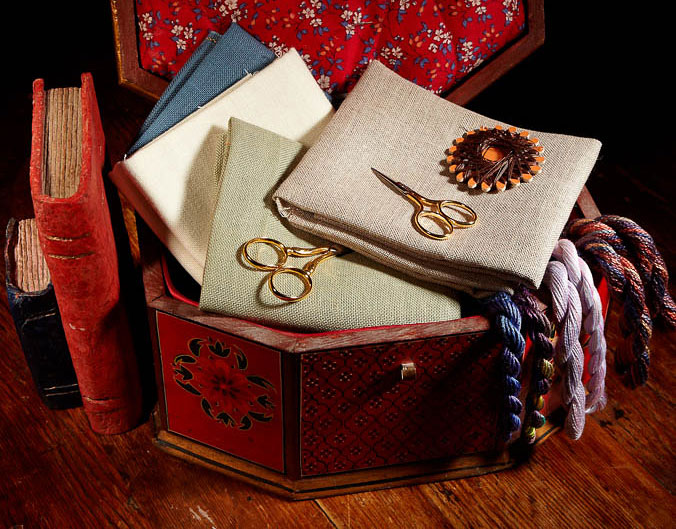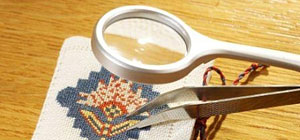Cross Stitch equipment

Needles
When working counted cross stitch you will need blunt tapestry needles of various sizes depending on your fabric selection. A blunt needle is required because you should be parting the threads of the fabric rather than piercing the material. You want to avoid splitting the fibres as you stitch.
Occasionally I use a ‘sharp’ needle when adding backstitch outlining or when creating fractional stitches on Aida fabric. A ‘sharp’ size 10 in useful for this and will double as a small beading needle.
The most commonly used tapestry needles for cross stitch are sizes 24 and 26, although needles are available in sizes 20, 22, 24, 26 and 28. When using a size 28, use only the equivalent of one strand of stranded cotton (floss) because the eye is very delicate and will break. Adjust the needle size to match the project.
Discard any old needles with marks or rough areas as these can damage threads and fabric. Avoid leaving your needle in the fabric when it is put away as it may leave a mark (unless you are working with gold-plated needles). The nickel plating on needles varies and some stitchers find they are allergic to the nickel and therefore prefer gold-plated needles.
I only use gold-plated needles as I find they slip through the fabric perfectly and are essential if creating lots of French knots or bullion knots.
If you are working on a floor-standing frame, you may find a double-ended needle helpful, where the eye of the needle is in the middle rather than the end. This means that the needle goes up and down rather like a shuttle in a loom.

Scissors
Keep a small, sharp pair of pointed scissors exclusively for your embroidery. I wear mine around my neck on a ribbon so that I know where they are at all times. There are magnets available to attach your scissors to the embroidery frame if you use one.
Use dressmaker’s shears for cutting fabric.

Magnifiers
There are a number of different types of magnifying contraptions on the market, some of which will make you look like something from the planet Zog but you will be among friends! There are various factors that will affect your choice.
If you already wear glasses for close work you may be able to find a cheap and simple pair of magnifying spectacles that will be just right for your stitching. In addition, there are small clip-on lenses that can be worn in addition to your glasses. Lenses can be worn around the neck and the position adjusted with side cords. The success or failure of these will also depend on your bust size as they do seem to need an adequate shelf to be in the correct position!
If you feel the need for something more substantial you will be able to find many excellent lenses with flexible arms which clip to the table, chair or embroidery frame. Some of these may be combined with a lamp.
Do make sure you hold your work at the correct distance from your eyes. To find this distance, hold your work at arm’s length then gradually bring it towards you until you can see it clearly. If you then continue to bring it nearer, you will find another point where it starts to become indistinct again. Hold your work at a distance between these two points where you can naturally see it most clearly. Most people, when they reach their forties, start to find that this position gets further and further away from their eyes. If this is happening to you, you probably need reading glasses, so consult an optician.

Lamps and Daylight Bulbs
Your requirements here will vary greatly depending on when you have the opportunity to stitch. An old-fashioned standard lamp is probably the most suitable as the soft light drops on your work from above and you are unlikely to burn yourself on the bulb!
Some stitchers have great success with head torches – the type purchased from camping shops. They vary enormously but the most successful type seems to be those with an adjustable beam, which can be angled on to your stitching.